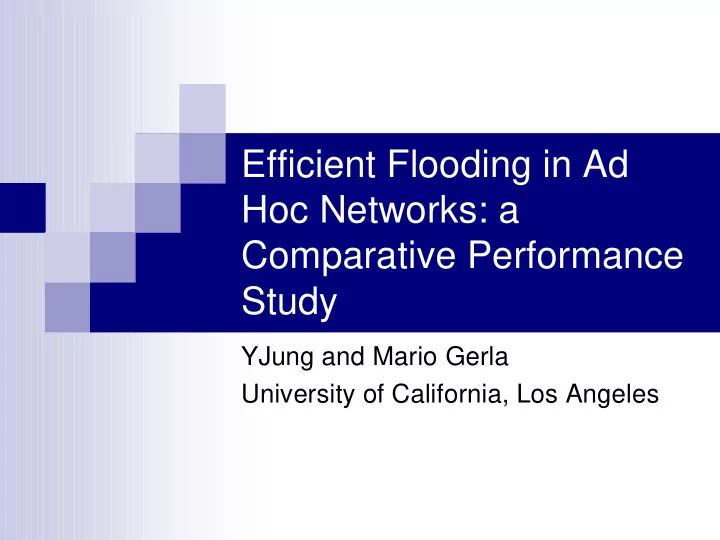

Efficient Flooding in Ad Hoc Networks: a Comparative Performance Study YJung and Mario Gerla University of California, Los Angeles
Introduction � Flooding � The basic mechanism to propagate control messages � Ex. route query flooding of reactive routing scheme � Blind flooding � All nodes in the network (re)-broadcast the packet � Inefficiency � Redundant and superfluous packets � High probability of collision and contention � Heavy congestion of wireless medium
Introduction (2) � Efficient flooding � A subset of dominant neighbors re-broadcast the flood packet to guarantee complete flooding � Contributions � We classify and evaluate existing efficient flooding schemes
Overview of Efficient Flooding � Neighboring topology based protocol � Source-tree based protocol � Cluster-based protocol
Neighbor Topology based Protocol Multi-Point Relay (MPR) � 1,3,4 2,3 � Use neighbors’ information within 2 two hops 1 � Selects a minimal subset of 4 forwarding neighbors (MPRNs) that 1,3,4 2,3 3 covers all the nodes two-hop away 1,2,3,4 GAF � � Use location information to choose minimal set of dominating nodes Stop forwarding � Excluded from our study due to the assumption of (extra) position information MPR: Node 1 chooses node 2 as MPRN
Source-Tree Based Protocol S � Builds a sh-path 2 source-tree rooted at 1 the flood initiator 3 4 � Rebroadcast if a node is on shortest path and non-leaf 5 � “Reverse Path Blue nodes (non-leafs) rebroadcast Forwarding”
Cluster-based Protocol � Clustering: grouping nodes into clusters S � Cluster head: a representative node of each group � Gateway: a node connecting more than two clusters � Ordinary nodes: Others � Efficient Flooding: only cluster ClusterHead heads and gateways Gateway rebroadcast Ordinary Node � Two clustering mechanisms � Active clustering: builds the cluster structure proactively � Passive clustering: builds the clusters passively, using on- going data traffic
Simulation Study � Environment � GloMoSim 2.0 � Target protocols: � MPR (F-MPR) � Active clustering with Lowest ID algorithm (F-AC) � Passive clustering (F-PC) � Reverse path forwarding (source-tree based protocol) (F-RPF) � Blind flooding (F-BF) � Protocols � UDP/802.11 DCF/two-ray propagation model � BW: 2MBits/sec � Power Range: 250meters � Single source initiates flooding 4 times per second
Performance Test v.s. Density Delivery Ratio Forwarding OH Delivery Ratio rank: � � F-BF >> F-PC >> F-RPF >> F-AC >> F-MPR Flooding efficiency rank � � F-RPF >> F-MPR >> F-AC >> F-PC >> F-BF MPR suffers due to inaccurate neighbor information -> insufficient # of dominating � nodes are chosen RPF works the best. But RPF needs a complex extension to be applied to multiple � floodings (multiple source trees) PC works overall okay �
Performance v.s. Mobility Delivery Ratio Forwarding OH � Rank does not change from the previous results � Passive clustering outperforms all (but BF): keep stable with increase of mobility
Applications : AODV Delivery Ratio Control OH Efficient flooding improves AODV performance at heavy load MPR works better than Pass Clustering at heavy load; but, MPR requires periodic table exchange – unfit for on-demand rtng
Conclusion � A comparative study of efficient flooding mechanisms � Results: � Passive clustering performs well for a broad range of node mobility and network density values � Passive clustering is the most robust � Accurate neighbor information collection is very challenging due to unreliable pkt delivery � MPR, active clustering shows bad performance in high mobility � Each scheme has a different set of suitable applications � F-PC for reactive routing protocols � F-MPR, F-AC and F-RPF for proactive schemes
Recommend
More recommend